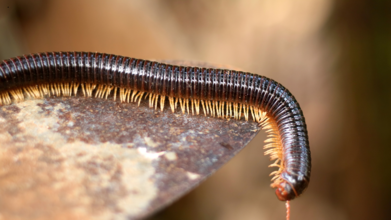- Health Conditions A-Z
- Health & Wellness
- Nutrition
- Fitness
- Health News
- Ayurveda
- Videos
- Medicine A-Z
- Parenting
- Web Stories
Why Breast Cancer Isn’t Just for Women

Why Breast Cancer Isn’t Just for Women
When we hear of breast cancer, the first thing that comes to mind is women. However, men are not exempt from this disease. Although it is rare, male breast cancer is on the rise, and more cases are being reported every year. Awareness of this overlooked condition can help break the misconceptions, promote early detection, and save lives.
Male breast cancer is less than 1% of all breast cancer diagnoses in the United States, with an estimated 2,800 cases in 2024. According to surgical oncologist Dr. Suneel Kaushik K, "The rarity of male breast cancer often leads to delayed diagnosis and treatment, making it crucial to foster awareness and education.
The lifetime risk of breast cancer in men is less than 1 in 1,000 at present. However, the incidence of this disease is on the increase, and most significantly so with increasing age in men. The average age at diagnosis for men is five years greater than that for women, and most men are diagnosed around the age of 67.
What Are the Risk Factors in Men
Several risk factors increase a man's likelihood of developing breast cancer. These include:
Advances in Age: The risk rises with age.
Genetics: Alterations of BRCA1 and BRCA2 are some of the most known alterations.
Family History: In case one's family has a history of breast cancer, risk will be high.
Lifestyle and Hormonal Factors: Excess weight, drinking, liver diseases, hormonal imbalance; including medical conditions like
gynecomastia and Klinefelter syndrome, also increase risk.
Radiation Exposure: Exposure to thoracic radiation treatment also increases risk.
According to Dr. Kaushik, "Knowing these risk factors is essential in identifying high-risk individuals who may benefit from early screening and monitoring."
Symptoms to Watch For
The symptoms of breast cancer in men are the same as those in women, but men often dismiss them because they are not aware of them.
Common signs include:
- A lump in the breast, usually painless
- Nipple discharge
- Dimpling, redness, or inversion of the skin or nipple
A man experiencing any of these should be clinically evaluated promptly to rule out cancer or detect it early.
Why Early Detection Counts
Mammography is not suggested in routine clinical practice in men due to the low prevalence of the disease. However, men considered to be at high risk-including family history and genetic tendency-should be encouraged for periodic mammography.
Dr. Kaushik emphasizes, "Early detection significantly improves treatment outcomes. For high-risk men, regular screenings and awareness of symptoms can make a life-saving difference."
How is Male Breast Cancer Different from Female
Male and female breast cancers have some similarities but also have many differences:
Most male breast cancers are invasive ductal carcinomas, with lobular carcinomas being extremely rare due to the absence of terminal lobules in the male breast.
A meta-analysis of male breast cancer reported that 99% of the tumors were estrogen receptor-positive, 82% progesterone receptor-positive, and 97% androgen receptor-positive. This all has implications for how a patient will be treated and what the prognosis will be, so these cases really require specialized care. Societal views of breast cancer as a "woman's disease" often lead to late presentation in males.
"Awareness is the first step to breaking barriers and encouraging men to take their symptoms seriously," Dr. Kaushik opines. "Healthcare providers play a key role in educating patients about risk factors and promoting vigilance."
Promotion of Awareness and Vigilance
Healthcare providers, advocacy groups, and communities should collaborate to raise awareness about male breast cancer. The steps toward this end are:
1. Promote symptoms and risk factors awareness amongst the general population.
2. Promote genetic testing and routine screening for those with a family history or genetic predisposition.
3. Normalize seeking care by openly discussing male breast cancer.
Breast cancer is not a disease that only afflicts women. Men, though less often, may suffer from this potentially fatal disease. Awareness, education, and aggressive healthcare can result in earlier diagnoses and better outcomes.
As Dr. Kaushik aptly states, “Addressing misconceptions about male breast cancer is not just about saving lives—it’s about ensuring equality in care and awareness for all.”
Men, just like women, should remain vigilant about their health, seek prompt medical attention if symptoms arise, and advocate for greater awareness of this under-recognized condition.
Dr Suneel Kaushik K is a Surgical Oncologist at American Oncology Institute (AOI) in Hyderabad, India
What Does Retracted Eardrum Mean? Here's All That You Need To Know About

Credits: Canva
A retracted eardrum, also called tympanic membrane atelectasis, is a condition where the eardrum gets pulled inward toward the middle ear. Normally, the eardrum (or tympanic membrane) acts as a boundary between the outer and middle ear, transmitting sound vibrations to tiny bones that help us hear. But when it collapses inward, that delicate process can be disrupted.
The condition is often silent at first, meaning people may not realize they have it. But in some cases, it can escalate, causing discomfort or even permanent hearing damage.
Spotting the Symptoms
In most cases, a retracted eardrum doesn’t cause any noticeable symptoms. But when the retraction becomes severe enough to affect structures inside the ear, individuals may experience:
- Earache
- Temporary hearing loss
- Fluid discharge from the ear
If left untreated, a chronic retracted eardrum can lead to permanent hearing loss.
Why Does It Happen?
The most common cause of a retracted eardrum is Eustachian tube dysfunction. These narrow tubes connect the middle ear to the back of the nose and help regulate ear pressure.
When they don’t work properly, pressure inside the ear drops, effectively pulling the eardrum inward.
Some common triggers include:
- Recent or recurring ear infections
- Cleft palate
- A poorly healed eardrum after rupture
- Enlarged tonsils or adenoids
Upper respiratory infections, such as the common cold
How Doctors Diagnose It
Diagnosis typically begins with a discussion about symptoms and any recent infections. A doctor will then use an otoscope, a tool with a light, to look into the ear canal. This allows them to visually confirm if the eardrum is abnormally positioned or collapsed.
Treatment Options: When to Wait and When to Act
Not all retracted eardrums require immediate treatment. In mild cases, doctors often recommend a “watch and wait” approach, as pressure may normalize naturally over a few months.
For more advanced cases, several interventions are possible:
Decongestants or nasal steroids: These can improve airflow in the ear and relieve pressure.
The Valsalva maneuver: This self-administered technique involves closing your mouth, pinching your nose, and gently blowing as if trying to pop your ears. It should be performed under medical guidance.
If the condition begins to affect hearing or causes persistent pain, surgical options may be considered.
Surgical Interventions
Two common surgical treatments are:
Tube Insertion (Myringotomy):
Often used in children with recurring ear infections, this procedure involves placing small tubes into the eardrum to help ventilate the middle ear.
Tympanoplasty:
In more severe cases, part of the damaged eardrum may be removed and replaced with cartilage from the outer ear. This stiffens the eardrum, preventing future collapses.
What’s the Prognosis?
The outlook largely depends on the severity. Minor retractions usually resolve without intervention and don’t cause long-term damage. However, more serious cases, especially those that persist or press against ear bones, may result in hearing loss and need medical or surgical correction.
Experts recommend seeking medical attention if you notice ear discomfort, hearing changes, or frequent infections. Early diagnosis can prevent long-term issues and protect one of your most important senses, your hearing.
Could Millipedes Help Treat Pain And Parkinson’s?

Credits: Canva
In a surprising discovery that bridges the gap between creepy crawlies and cutting-edge neuroscience, researchers at Virginia Tech have identified unique compounds in millipede secretions that could pave the way for future treatments for pain and neurological diseases like Parkinson’s, depression, and schizophrenia.
Led by chemist Emily Meyers, the research team uncovered naturally occurring alkaloids in the defensive secretions of the Andrognathus corticarius, a species known colloquially as the Hokie millipede. The millipede, which lives under decomposing leaves and branches on the university’s Blacksburg campus, produces a chemical cocktail that not only deters predators but may influence neuroreceptors in the brain.
“These compounds are quite complex, so they’re going to take some time to synthesize in the lab,” said Meyers, who specializes in studying underexplored ecological sources for potential new drugs.
A Hidden Chemical Arsenal
The compounds, dubbed andrognathanols and andrognathines by Meyers’ team, belong to a class of complex alkaloids. They were discovered after researchers collected several millipedes from wooded areas on campus and analyzed the contents of their defensive glands using a suite of chemical tools.
The results were striking: some of these secretions had a disorienting effect on ants, one of the millipede’s presumed predators. But that’s not all, several of the compounds were found to interact with a neuroreceptor known as Sigma-1. This receptor has been linked to multiple brain disorders, including schizophrenia, depression, Lou Gehrig’s disease (ALS), and Parkinson’s disease.
In addition to warding off predators, the researchers discovered that the compounds may also serve a social function, possibly helping millipedes signal their location to family members in leaf-littered environments.
From Defense to Drug Discovery
This study, recently published in the Journal of the American Chemical Society, is not Meyers’ first foray into studying arthropod chemistry. She has been collaborating with entomologist Paul Marek, and together, they have previously suggested that the family of alkaloids found in millipede secretions could have significant therapeutic potential.
“Millipedes have been around for hundreds of millions of years. They’ve developed these intricate chemical defense systems, and we’re only beginning to understand their value,” said Meyers.
While the compounds show promise, the next hurdle is a familiar one in drug discovery: scalability. The compounds exist in trace amounts in the wild, and researchers need larger quantities for in-depth testing and potential pharmaceutical development.
The Road Ahead
The team is now exploring partnerships with laboratories that can synthesize the compounds in bulk, which would allow for further testing on their biological activity and medicinal properties. Meyers emphasized that while the research is still in its early stages, the potential applications are broad, from pain management to novel treatments for complex neurological conditions.
“Nature has always been a wellspring of inspiration for medicine,” said Meyers. “And sometimes, the most powerful solutions come from the smallest and most unexpected creatures, like a tiny millipede under a log.”
With this groundbreaking discovery, scientists are reminded once again that the natural world may hold secrets that, once unlocked, could transform human health in unimaginable ways.
Low Grade Prostate Cancer Could Be Increasing Health Risks By 30%

(Credit-Canva)
Cancers are unpredictable and can be either containable or completely wreck your health. To make cancer treatments and research better, healthcare professionals use stages and characteristics, making it easier for us to categorize and identify how far along the disease is. However, recent research has been questioning our stance on this particular cancer, saying it could be worse than what we had believed.
A recent study has found that a specific type of prostate tumor, called Grade Group one (GG1), might not be as harmless as once believed. While many doctors consider these tumors to be at low risk of spreading and recommend monitoring them, the new research suggests the true risk might be higher. In fact, the study indicates that up to 30% of these cases could be more serious than doctors think, and a closer look could save lives.
Challenge with Current Practices
For years, men diagnosed with a GG1 tumor were often told to skip immediate treatment and instead undergo "active surveillance." This means they were regularly checked with blood tests and follow-up biopsies to see if the tumor was growing.
However, researchers point out a key problem: a single biopsy might miss more aggressive cancer cells located in a different part of the prostate. This could lead to a patient being undertreated, which could have serious consequences later on if the cancer grows. The authors believe that relying on just one biopsy to decide on treatment is a flawed approach.
What Are Low-Grade Prostate Tumors?
According to a 2022 review published in the Urological Research Society, the lowest grade of prostate cancer, called ISUP Grade Group 1 (GG1), grows very slowly. Because it is so harmless, some experts have suggested that we should stop calling it "cancer" at all. This has been done before for similar low-risk tumors in the bladder and thyroid.
The review summarized that even though GG1 tumors have some characteristics of cancer, their behavior is much more like a harmless, non-cancerous growth. The authors suggest that renaming GG1 prostate cancer could have several benefits:
- It could help prevent unnecessary treatments.
- It would reduce a patient's fear and stress.
- It could lower the financial costs for patients and the healthcare system.
Study's Findings
Challenging the view of previous studies, researchers sought to get a clearer understanding. To get a more accurate picture, the research team looked at data from over 300,000 men. Among those who were initially diagnosed with GG1 tumors, the team used additional factors like PSA levels and tumor size, which can be better indicators of risk.
By combining all this information, they found that a significant number of men—more than 18,000—were actually at higher risk and should have received more aggressive treatment like radiation or surgery. This data strongly suggests that as many as 30% of GG1 diagnoses might be underestimated, leaving many men without the full treatment they need.
Call for Change
The authors of the study are urging doctors to reconsider how they evaluate GG1 tumors. They emphasize that a "low grade" diagnosis from a biopsy isn't the same as a guaranteed "low risk" for the patient. They believe it's a doctor's responsibility to use all available data to accurately assess a man's individual risk. The goal is to ensure that those who need treatment get it, while still safely recommending active surveillance for the men who are truly at low risk.
© 2024 Bennett, Coleman & Company Limited

